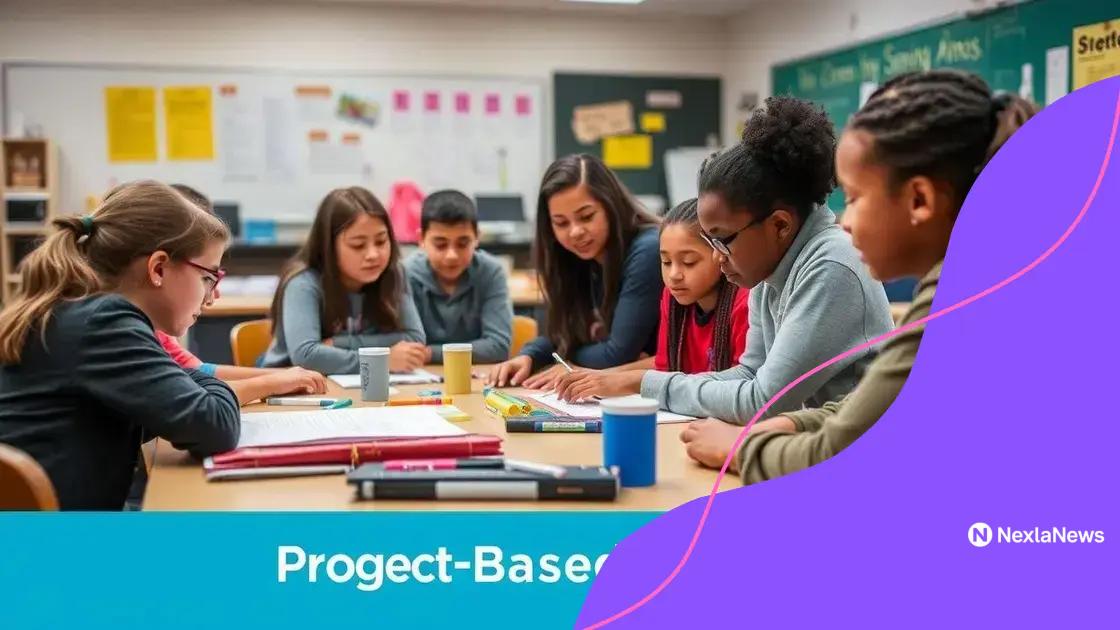Inquiry-based learning: a path to deeper engagement

Inquiry-based learning actively engages students by encouraging them to ask questions, explore topics, and participate in hands-on projects that enhance critical thinking and collaboration skills.
Inquiry-based learning transforms traditional education by placing students at the center of their learning. Have you ever wondered how engaging it could be to explore topics driven by curiosity? Let’s dive into this innovative approach and see how it can enhance learning experiences.
Understanding inquiry-based learning
Understanding inquiry-based learning is crucial for educators looking to inspire students. This method encourages curiosity and fosters a deeper connection with the material being studied.
The foundation of inquiry-based learning lies in asking questions and exploring answers. In contrast to traditional learning, where information is simply delivered, this approach invites students to take an active role in their education.
Key Principles of Inquiry-Based Learning
There are several core principles that define this learning model. Understanding them can help educators implement effective inquiry-based practices.
- Student-Centered: Learning is driven by students’ interests and questions.
- Engaging Questions: It starts with asking thought-provoking questions that require investigation.
- Active Exploration: Students participate in hands-on activities and discussions to explore their questions.
- Collaboration: Inquiry fosters teamwork, with students often working together to solve problems.
As learners engage with their curiosity, they develop important skills like critical thinking and problem-solving. These are essential for success both in school and in real-world situations.
By fostering a classroom environment that welcomes inquiry, educators can help students feel more connected to their learning process. This leads to greater motivation and a desire to explore topics deeply, enhancing overall educational outcomes.
Additionally, inquiry-based learning empowers students to take ownership of their education. Instead of passively receiving information, they become active participants, which can lead to increased engagement and enthusiasm.
By valuing students’ questions, teachers signal that exploration and curiosity are important. This validation encourages students to dive deeper into subjects that interest them.
As such, inquiry-based learning not only enhances the educational experience but also prepares students for lifelong learning.
The benefits of inquiry-based learning
The benefits of inquiry-based learning are extensive and impactful. This method not only enhances students’ knowledge but also encourages skills that are vital for their future.
One significant advantage of inquiry-based learning is that it promotes critical thinking. Students learn to analyze information, ask questions, and draw conclusions based on evidence. This process helps them become more adept at problem-solving.
Engagement and Motivation
Inquiry-based learning naturally increases student engagement. By pursuing topics that interest them, students are more motivated to learn. This approach allows them to take ownership of their education, leading to a deeper connection with the material.
- Higher Retention: Students often remember concepts better when they discover them through inquiry.
- Collaborative Skills: Working with peers enhances communication and teamwork.
- Creativity: Inquiry encourages innovative thinking and the exploration of new ideas.
- Adaptability: Learners become more flexible as they navigate complex problems.
Furthermore, as students engage with their peers, they develop social skills essential for working in teams. They learn to listen, share ideas, and respect different perspectives. These interpersonal skills are valuable not only in school but also in future workplaces.
Another notable benefit is the development of a lifelong love for learning. When students are encouraged to ask questions and explore, they are more likely to continue seeking knowledge outside of the classroom. This curiosity fosters a culture of continuous improvement and learning.
Inquiry-based learning also supports the diverse needs of students. It caters to different learning styles and paces, allowing everyone to engage at their level. This flexibility can lead to greater academic success across various subjects.
Effective strategies to implement inquiry-based learning

Effective strategies to implement inquiry-based learning can transform the educational experience for students. These strategies empower learners to explore and discover knowledge actively.
One strong approach is to start with open-ended questions. These questions encourage students to think critically and pursue their interests. For instance, instead of asking for a specific answer, ask students how they might solve a problem or what they think might happen in a certain scenario. This approach fosters a spirit of inquiry.
Creating a Supportive Environment
It’s essential to build a classroom environment that supports inquiry. This means providing resources, materials, and tools that inspire exploration. For example, having access to books, technology, and hands-on materials allows students to dive deeper into their subjects.
- Encourage Collaboration: Group work can stimulate creativity and diverse perspectives.
- Use Real-World Problems: Connecting lessons to real-life challenges makes learning more relevant.
- Foster Reflection: Allow time for students to reflect on what they learn and how they learn.
- Integrate Technology: Technology tools, like educational apps, can enhance the inquiry process.
Incorporating these elements makes learning engaging and relevant. As students work together on projects, they learn vital collaborative skills. This teamwork allows them to contribute their unique ideas, enriching the learning experience for everyone.
Another effective strategy is to use formative assessments. These assessments help teachers gauge student understanding and guide instruction. Instead of focusing solely on grades, encourage feedback and discussions about what students learned and how they reached their conclusions.
Lastly, it’s important to model inquiry behavior as an educator. Show enthusiasm for exploration and question asking. When students see you engaged, they are more likely to take an active role in their learning. This enthusiasm can be contagious, inspiring them to delve deeper into their own inquiries.
Challenges in adopting inquiry-based learning
Challenges in adopting inquiry-based learning can be significant but are also manageable. Educators and schools may face obstacles when trying to implement this engaging teaching method.
One major challenge is the need for professional development. Teachers often require training to effectively guide an inquiry-based classroom. Without proper resources and guidance, it can be tough for educators to feel confident in this approach.
Time Constraints
Another barrier is the time constraints within the school curriculum. Traditional teaching methods often prioritize content delivery over exploration. This means teachers must find a balance between covering required materials and allowing students the time needed for inquiry.
- Curriculum Alignment: Ensuring inquiry-based activities align with state standards can be difficult.
- Classroom Management: Facilitating group work and discussions requires strong management skills.
- Assessing Learning: Measuring success in an inquiry-based framework can be complex.
- Resource Availability: Accessing necessary materials and technology can be an obstacle.
Moreover, some students may feel uncomfortable in an inquiry-based environment. They might be accustomed to traditional teaching styles where they receive information directly. This can lead to feelings of confusion or frustration as they adapt to a more open-ended approach.
Another significant hurdle is the need for support from administration. Without buy-in from school leaders, it can be tough to make systemic changes that support inquiry-based learning. Policies and scheduling must also reflect this shift in teaching style to be successful.
Additionally, parents may need education on the benefits of inquiry-based learning. Some might question the effectiveness of less direct instruction. Providing information about how this method can enhance critical thinking skills and engagement is essential for gaining parental support.
Examples of success in inquiry-based learning
Examples of success in inquiry-based learning illustrate how this approach can transform classrooms. Many educators have successfully implemented inquiry-based methods, yielding impressive results.
One prominent example is the use of project-based learning in science classes. Students may investigate local environmental issues, such as pollution in a nearby river. They can conduct experiments, gather data, and present their findings to the class. This not only teaches scientific concepts but also develops critical thinking and collaboration skills.
Case Study: A Student-Led Research Project
At a middle school in California, students initiated a project on renewable energy sources. They researched different technologies, conducted experiments, and created presentations. Their enthusiasm led to the creation of a renewable energy fair, engaging the entire school community.
- Increased Engagement: Students were highly motivated to learn due to the real-world application.
- Collaboration Skills: Working in teams taught students how to communicate effectively.
- Confidence Building: Presenting to an audience helped students gain confidence in their abilities.
- Community Involvement: The project fostered partnerships with local energy experts.
Another successful example comes from a high school English class. Students examined classic literature through the lens of modern themes. They posed questions about the relevance of the text today and engaged in discussions and debates. This inquiry-driven approach led to deeper understanding and appreciation of the material.
Teachers also reported that inquiry-based learning fosters a culture of curiosity. Students began to ask more questions, leading to richer class discussions. Not only does this enhance the learning experience, but it also prepares students for higher education and future careers.
Furthermore, inquiry-based learning cultivates a sense of ownership among students. They take pride in their projects and are motivated to succeed, knowing their work results in tangible outcomes. This sense of responsibility contributes to a positive classroom environment.
FAQ – Frequently Asked Questions about Inquiry-Based Learning
What is inquiry-based learning?
Inquiry-based learning is an educational approach that encourages students to ask questions, investigate, and explore topics deeply, promoting critical thinking and engagement.
What are the benefits of using inquiry-based learning?
This method enhances student engagement, fosters critical thinking skills, encourages collaboration, and connects learning to real-world applications.
What challenges might teachers face when implementing inquiry-based learning?
Teachers may encounter challenges such as needing additional training, time constraints, classroom management issues, and ensuring alignment with curriculum standards.
How can inquiry-based learning be effectively implemented in the classroom?
Effective implementation includes using open-ended questions, creating a supportive environment, integrating technology, and encouraging collaboration among students.
